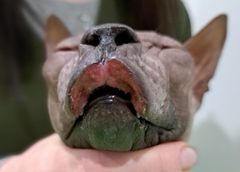Moulting in animals
Опубліковано
20.01.2023
Moulting
Shedding is a normal occurrence in dogs and cats. Some animals shed more in spring and fall, while others shed all year round.
It is a misconception that long-haired dogs and cats shed the most. Short-haired animals have a denser coat and tend to shed more, but the length of their hair makes it less noticeable.
There are many reasons why a dog or cat sheds excessively.
1. One of the first things to do if this happens is to look at the animal's coat. Does the coat have a healthy shine? Does the skin under the coat look normal, or is it flaky, dry, or discolored?
Let's first look at the stages of hair growth:
- The anagen phase, when new hairs grow;
- Catagen phase, when hairs reach their full length and stop growing;
- Telogen phase, when hairs are at rest.
- Exogenous phase: hairs fall out.
The amount and frequency of shedding depends on factors such as the animal's health, breed, and environment.
During normal coat change, animals do not experience itching, alopecia, flaking, redness, skin damage, and there is no excessive greasiness of the coat. The coat looks healthy, and the pet's condition is assessed as good.
2. Pathological shedding is usually associated with changes in the appearance of the coat and skin.
3. Stress is a factor contributing to hair loss. Under severe stress, a lot of hair can immediately go into a resting phase, as a result of which it falls out at the same time, and not at different times.
4. If your pet is shedding and scratching excessively, it may have fleas or ticks. These parasites, and the itching and scratching they cause, can lead to more serious health problems, including skin inflammation and secondary skin infections.
5. Allergies - can be the main cause of your pet's shedding. There are three types of allergies. Food allergy, parasite allergy, and atopy (allergy to environmental allergens).
6. Diseases of the kidneys, liver, thyroid or adrenal glands (including Cushing's disease)
7. Oncological diseases
8. Autoimmune diseases
If you notice bare skin or redness on your pet's skin, it's time to make an appointment with a dermatologist. Based on the history and examination, the main cause of the shedding can be determined.
During the examination, a veterinary dermatologist can perform the following tests
Luminescence diagnostics to exclude certain types of dermatophytosis (mange).
- "Wet test" to detect flea feces on the pet's body.
- Deep and superficial skin scraping to exclude other parasitic diseases.
- Cytological examination of the skin to determine the cellular composition of the skin surface or the nature of the lesions. Trichoscopy - assessment of the quality of the coat under a microscope.
- If necessary, additional tests are performed, such as histological examination.
Excessive shedding can sometimes be prevented by proper nutrition, and your pet's skin and coat are a direct reflection of the basic nutrients it receives.
Optimal skin and coat health requires the right ratio of omega-3 and omega-6 fatty acids, as well as the addition of some essential vitamins and minerals that your pet's skin needs.
Carry out regular parasite treatments, avoid stress, have a balanced diet, and take care of your pet's skin as recommended by your veterinarian. Good health to you and your pets.
Схожі статті

Preparation for ultrasound examination (ultrasound)
It is important to remember that proper preparation of the animal can significantly facilitate the abdominal ultrasound process. By performing this procedure, the doctor can detect possible problems in time and provide proper treatment. High-tech ultrasound is one of the ways to quickly and informatively diagnose and ensure a long and healthy life for our pets.

Brachycephalic syndrome in dogs and cats.
What exactly is brachycephalic syndrome and how to live with it, how to prevent complications for the body that this syndrome can lead to?

WHY ARE DOCTORS NOT ALL-POWERFUL?
A good doctor is worth its weight in gold. Everyone understands this and can spend years looking for the best one, and when they find one, they will expect miracles.

Allergy
Allergy

SYNDROME OF TIRED TANKLES IN CATS
Tired antennae of a cat or What do you know about fatigue?

Bacterial myocarditis
This disease is extremely rare in dogs. In cats, it is even less common - 0.006-0.018% of cases.

How to protect home lovers from radiation damage.
In recent days, we have received many calls asking for advice on the need to protect animals during a possible radiation exposure.

STERILIZATION AND CASTRATION OF CATS AND DOGS
Such operations do not affect the change of the animal's character. They can be done from an early age, in particular from 8 weeks. Convenience, first of all for the animal, is that the young organism has the ability

Side effects of antiparasitic drugs
The need for tick and flea treatments for pets is a well-known fact.

How you can help calm cats and reduce stress today
the head of the felinology department, tells us.

